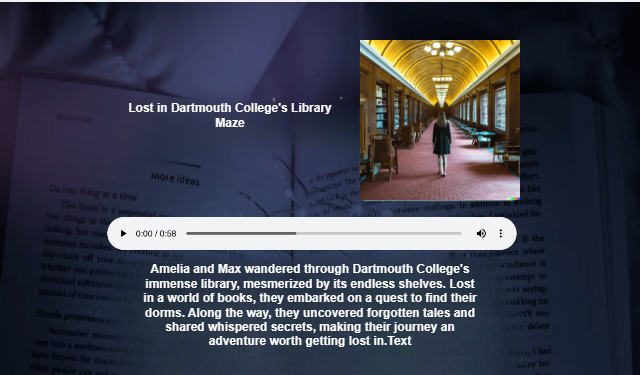An innovative open-source event-driven application that crafts a fresh bedtime tale for your little ones every night. Powered by Lambda, EventBridge, DynamoDB, App Runner, ChatGPT, and DALL-E.

- ⏱️ EventBridge Scheduler for daily bedtime story generation
- 📦 Event-driven architecture leveraging Amazon EventBridge to orchestrate the processing of images, audio, and emails.
- 🤖 Fresh, one-of-a-kind stories each night brought to life by ChatGPT and DALL-E for images
- 🧑💻 Deployable via AWS CDK
-
Every day, at a predefined time, an EventBridge Schedule triggers a Lambda function.
-
The
create-storyLambda function retrieves characters and scenes from Amazon DynamoDB tables and employs ChatGPT (OpenAI API) to weave a captivating story. This story is stored in DynamoDB with a 2-day TTL (Time to Live). -
An Amazon EventBridge Pipe is set up to monitor new items created within the table using streams. It subsequently triggers an Amazon EventBridge event (StoryCreated).
-
EventBridge directs the
StoryCreatedevent to three destinations:
- SNS for email notifications
- SNS is utilized to inform the user about the freshly generated story.
- AWS Lambda function for audio generation
- Lambda generates audio content for the story via Amazon Polly. The audio file is then stored in S3 with a signed URL (valid for 2 days).
- AWS Lambda function for image generation.
- This Lambda function crafts an image for the story using DALL-E (OpenAI API). The resulting image is stored in S3 with a signed URL (valid for 2 days).
- The frontend application is hosted on AWS App Runner and runs a NextJS SRR application. When users access the URL via email (through the SNS topic), the story is fetched and displayed.
This application was conceived as a proof of concept. If you intend to extrapolate its patterns, there are several design considerations to ponder.
This application is geared towards individual use, sending a daily story URL to a single recipient. Scaling to accommodate multiple users necessitates architectural adjustments.
The frontend application, constructed with NextJS, resides in App Runner. The App Runner container is granted permissions to interact with the DynamoDB table to access stories. Stories are automatically purged from the table after 2 days due to TTL settings.
Upon story creation, EventBridge emits events to multiple consumers (audio processing, image creation, and SNS), potentially resulting in race conditions. There may be instances where audio or images are not yet available when the user accesses the story. The application checks for the presence of audio and images, reverting to rendering only the story if this data is not yet accessible (owing to asynchronous processing). While this approach suffices for simple use cases, waiting for completion may necessitate exploration of patterns such as aggregators or step function workflows to manage state.
The application, being relatively straightforward, utilizes three tables. The characters and scenes table experiences infrequent updates, while the stories table stores the generated stories. Scaling for numerous users demands thoughtful consideration of access patterns and table design.
- OpenAI API Key
- Node v16 or higher
- AWS CDK
Begin by obtaining an OpenAI API key. If you do not possess an account, you must create one. Get started here.
Once you have your API key, add it to Secret Manager with the secret name set as open-api-key.
-
Clone the repository.
-
Modify the
config.jsonfile (add your email address and cron job). -
Execute
npm run install:all. -
Run
npm run deploy:- This operation deploys three stacks (Tables, Frontend, Backend) into your AWS account using CDK.
- Deployment may take a few minutes to complete (containers need to initialize).
-
Populate your DynamoDB databases (Scenes and Characters):
- You can find the files in
/backend/data/. Customize these files as needed. - Execute
npm run populate-dbto populate these tables.
- You can find the files in
-
Once completed, your application is ready.
The EventBridge scheduler triggers your Lambda function to generate a story at the configured time specified in your config.json file (default is 7:15 PM).
You can also manually invoke the function (-aiStoriesBackend-scheduledlambdafunction) for on-demand story generation.
